Maingear Shift in Detail
Our Shift features Super Stock options, a configurable series of paint jobs (both internal and external), upgraded cooling, acoustic dampening treatments, and more. Our evaluation unit was sprayed Brandywine red on the outside with a solid black interior. Other available colors include Root Beer (orange), Organic Green, Frost White, Cobalt Blue, and Burple (purple).
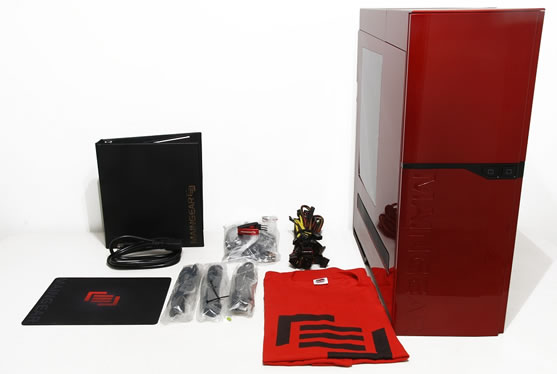
The system is hand-painted using high quality automotive paint. As you can see from the photos, the paint looks very nice in general but upon closer inspection, we found a few sections where it was subpar or a piece of debris was lodged in the finish – lint perhaps. Based on touch, some of the imperfections seem to be in the paint while others are attached to the clear coat. Unfortunately, they proved too difficult to photograph since we don't have a macro lens. It also appears that the chassis wasn't disassembled fully prior to painting. This is most noticeable on the right side of the front bezel door where a large crevice didn't get enough paint.
The front bezel door swings open to reveal three 5.25" bays and a 3.5" bay. Our review sample features two optical drives: a 10X LG Blu-ray burner and a 24X Dual Layer DVD RW drive. The power and reset buttons are also on the front bezel, but not behind the door. The power and HDD activity LEDs aren't visible looking at the chassis from the front. They are "hidden" behind the front bezel and only visible when viewed from an angle – kind of weird.
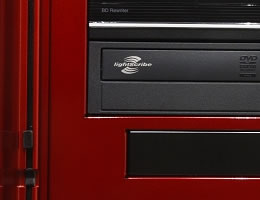
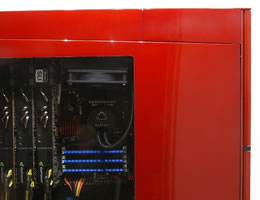

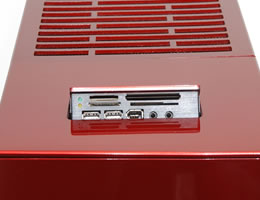
As part of the Super Stock options, our system features a seamless window on the left side panel and white LED lighting inside. The window is flush mounted with the panel and there are no rivets or screws visible from the outside.
The back of the system looks a bit unusual as the I/O panel is on top of the case. The power supply, however, is mounted at the bottom of the chassis, although recessed a good bit into the case.
The right side panel shows off the deep red paint job and features a horizontal strip of mesh for ventilation, much like we saw on the left side.
The bottom of the case has two cooling vents and is raised off the ground to allow air to flow in freely. Do note that the front of the case doesn't have any case feet, but rather the front bezel itself sits on the floor. This could be a concern for the paint job should you happen to slide your case around on a hard surface.
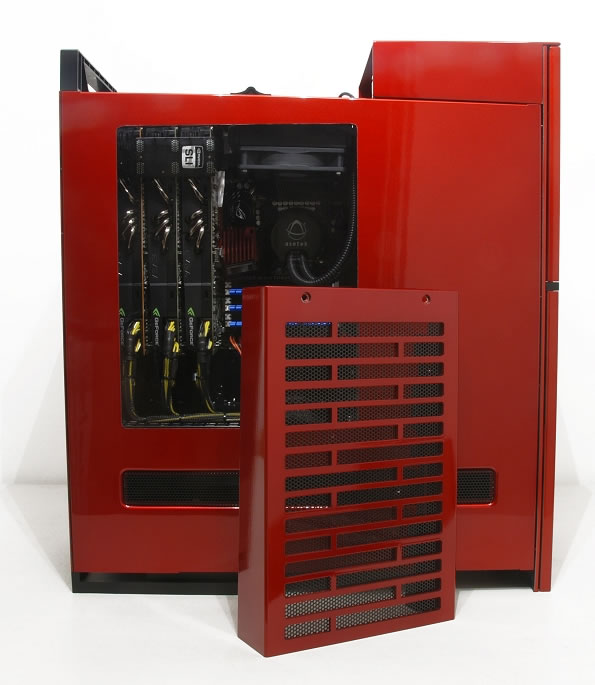
On top of the case is a pop-up I/O panel with a multi-card reader, two USB ports, Firewire port and headphone/microphone jacks. As you can see in the photos, the panel sits slightly more to the right in its designated hole. Meanwhile, the ports are positioned more to the left, leaving plenty of unoccupied space on the right. It's not terribly obvious, but in a chassis of this caliber, it did stand out.
To access the "rear" I/O panel, you must remove the cable cover plate that is held in place with two screws and is vented to let hot air exit the top of the case. The same cover must be removed to detach the side panels and gain access to the inner chassis.
The I/O panel features multiple connections. From top to bottom: Two USB 2.0 ports, PS/2 Keyboard, Clear CMOS, S/PDIF out, powered eSATA, 1394 Firewire, four USB 2.0 ports, Network jack, ROG Connect on/off, Bluetooth Switch, RC Bluetooth, USB port / ROG connect port, USB 3.0 ports and audio ports.
Each of the three video cards has two DVI ports and an HDMI port. A 120mm exhaust fan, part of the liquid cooler for the CPU, sits beside the I/O shield with the Windows product key just above the fan.
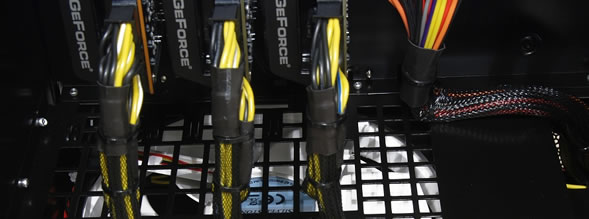
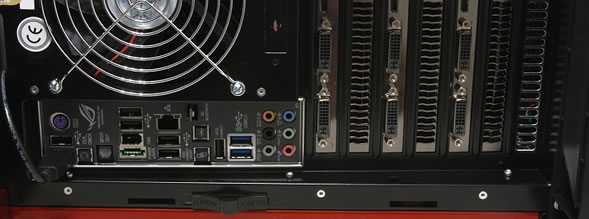
To get inside, you have to push the side panel switch forward and pull out and up on the panel. Despite being such a large chassis, there really isn't much extra room inside with the three large graphics cards and the radiator for the CPU cooler. Even so, Maingear has once again done a fantastic job with cable routing. Either every cable is run behind the motherboard or zip-tied down to hold its location.
Aside from the visible hardware, there are a few important features to point out. First is the tool-less hard drive bay, which holds up to six drives that are mounted on a nylon drive rail.
There are two large 180mm cooling fans, one just above the power supply and another under the drive bays. These both suck air from the bottom of the case and direct it up to the video cards and hard drives, respectively.
